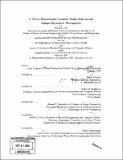A three-dimensional coupled modes solution for range-dependent waveguides
Author(s)
Luo, Wenyu
DownloadFull printable version (6.945Mb)
Alternative title
3D coupled modes solution for range-dependent waveguides
Other Contributors
Woods Hole Oceanographic Institution.
Advisor
Henrik Schmidt.
Terms of use
Metadata
Show full item recordAbstract
Despite the great achievements obtained with fast-field and parabolic equation models, normal mode programs still remain a very efficient, simple and practical tool for describing ocean acoustics in range-independent environments. Numerical implementations of wave-theory solutions for range-dependent acoustic problems can be classified as: normal-mode techniques (adiabatic or coupled modes); parabolic-approximation techniques (narrow- or wide-angle parabolic equations solved by split-step or finite-difference techniques); and finite-element/finite- difference solutions of the full wave equation. The mode techniques provide approximate field solutions if implemented in the adiabatic approximation, while complete wave theory solutions can be obtained by including full mode coupling. Parabolic approximations to the elliptic wave equation have been extensively studied over the past 10 years([15], [23]). The advantage of using a parabolic wave equation is that it can be efficiently solved by noniterative forward marching techniques. However, any form of the parabolic equation is an approximate wave equation derived under the assumptions of: (1) forward propagation only, and (2) that energy is propagating within a limited angular spectrum around the main propagation direction. The last category of models based on finite-difference and finite-element solutions of the full wave equation([22]) is well suited for providing solutions for propagation in general range-dependent environments. (cont.) The existing codes, however, are extremely computer intensive. My thesis focuses on a two-dimensional two-way coupled modes model, and then expend it to a three-dimensional coupled modes model for two-dimensional, range- dependent waveguides. Numerical examples of two-dimensional and three-dimensional problems are presented, and comparisons with the results from analytical solution, as well as from COUPLE are also considered.
Description
Thesis (S.M.)--Joint Program in Oceanography/Applied Ocean Science and Engineering (Massachusetts Institute of Technology, Dept. of Ocean Engineering; and the Woods Hole Oceanographic Institution); and, (S.M.)--Massachusetts Institute of Technology, Dept. of Electrical Engineering and Computer Science, 2005. Includes bibliographical references (p. 149-151).
Date issued
2005Department
Joint Program in Oceanography/Applied Ocean Science and Engineering; Woods Hole Oceanographic Institution; Massachusetts Institute of Technology. Department of Electrical Engineering and Computer Science; Massachusetts Institute of Technology. Department of Ocean EngineeringPublisher
Massachusetts Institute of Technology
Keywords
Joint Program in Oceanography/Applied Ocean Science and Engineering., Ocean Engineering., Electrical Engineering and Computer Science., Woods Hole Oceanographic Institution.